Material Culture: Week 7: Inscriptions
1/68
There's no tags or description
Looks like no tags are added yet.
Name | Mastery | Learn | Test | Matching | Spaced |
|---|
No study sessions yet.
69 Terms
Show an image of Nestors cup:
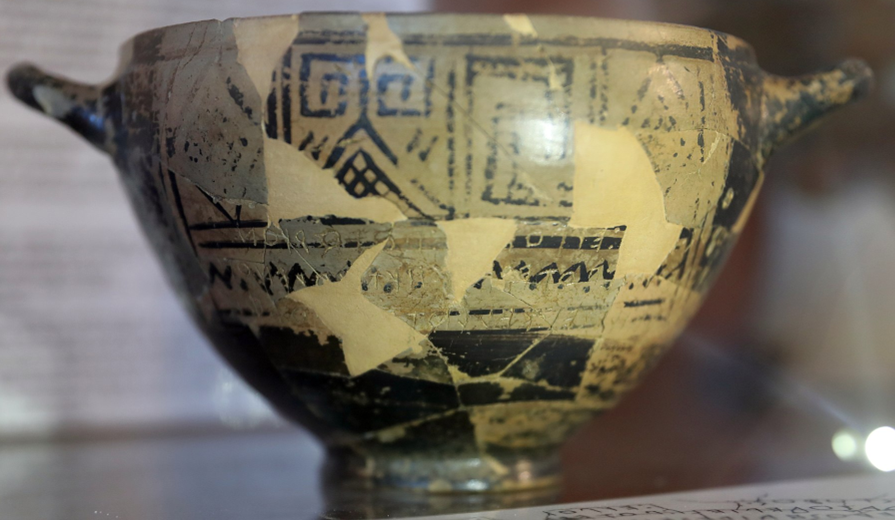
When/where is the cup from and where was it found?
Cup from 8th C BC, the cup was manufactured in Rhodes, and its a geometric style of pottery. It was found in a grave dated 700BC, with a silver broach.
What is on the left hand side of the cup?
On the left hand side it has early greek writing scratched on the surface after firings- must read from right to left
What does the inscription on the cup say?
The inscription: I am the cup of Nestor good for drinking. Whoever drinks from this cup, desire for beautifully crowned Aphrodite will seize him instantly.
What style is the inscription in and what does it allude to?
The inscription is in hexametre, and it illudes to a passage in book 11 of the Iliad (a beautiful cup belonging to Nestor)
What might this cup be contrasting?
This cup may be contrasting the cup in the epic
What is the cup not and how do we know?
This cup obviously isnt the one in Homer
It wasnt found in greece but on the western coast of Italy
Is the cup damaged?
This cup is damaged and the letters that are in squared brackets are editorial editions. It means that the interpretation of the text isnt fully clear but it does definitely allude to Homer
What does this cup show?
It shows the interconnectedness of the mediterranean so early on and shows the prestige of Homer and his stories
Where can we see an example of diversity in the roman world?
On the cross of christ originally there was a trilingual inscription (three languages). Even an isncription on a wooden cross may have used three different languages to engage different audiences
Write out the translation of the text on the tomb of regina:
‘To the departed spirits of Regina, his freedwoman and wife, a Catuvellaunian, aged 30. Barates of Palmyra.
Regina, the freedwoman of Barate, alas.’
Was this text in multiple languages?
Yes
What does Regina mean and what do we know about this woman?
Regina means queen so she has taken her name for status, but we know that she was a freedwoman. We also known she was a british woman that was enslaved, who was then freed by someone from Syria (Birates?)
Why may the inscription be inaccurate?
The inscription says she died at the age of 30 (possibly not accurate as they did age rounding)
How do the different languages on the tombstone show differing emotions?
The latin is unemotional it just describes the deceased, while the other language Palrimi is more emotional- the word ‘alas’, gives an idea of mourning which isnt present in the latin
Describe the tombstone:
Reginas tombstone as a monument- Its a pediemented areas with someone sitting in a throne almost (this woman is Regina), she is depicted with various attributes that combine roman, british and Playrimi things (Palyrimi is in Syria). The pearl drop earrings are palyrimi. There is also a wool basket on the left hand side- alluding to the roman woman who stays at home and does her wool-working
Opposite the woolworking is a jewlery box with a lock
What does this tombstone tell us about her husband?
This tells us about her husbands sense of identity and how he wanted her to be remembered (all the palyrimi stuff, we are unsure if she would have every even gone there)
Show an image of Regina’s tombstone:
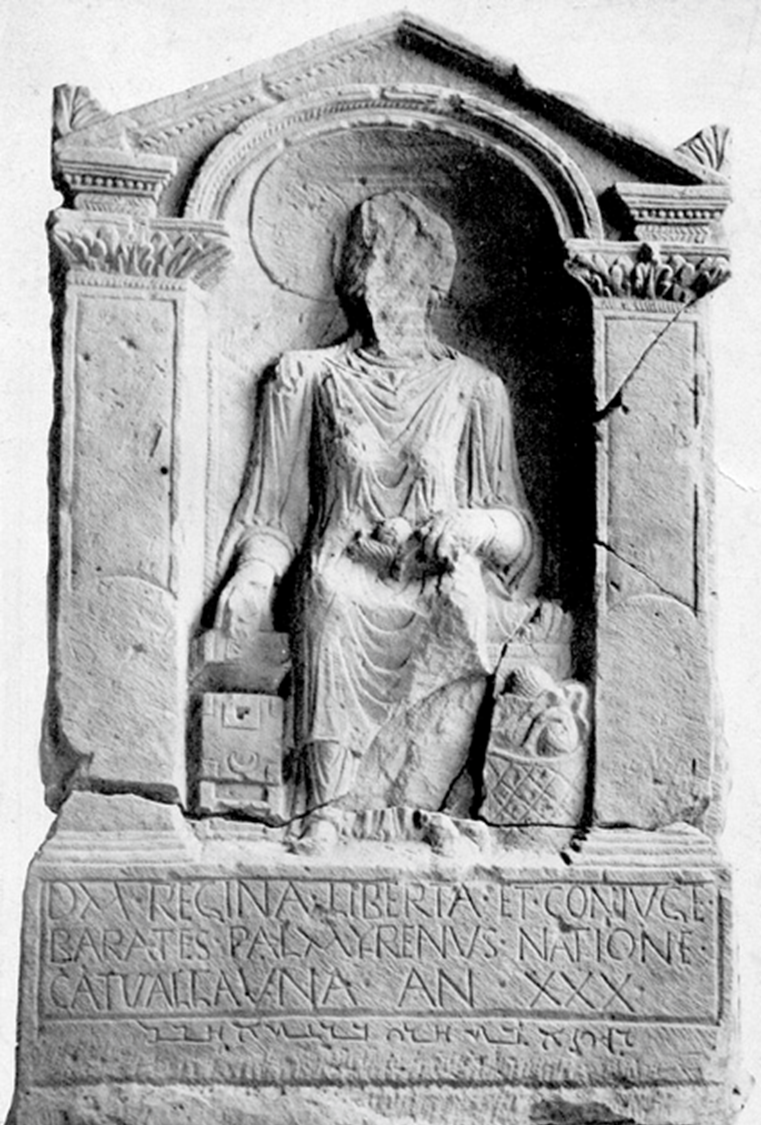
Give an example of common non-perishable items that have inscriptions:
Vases, steles, cups and bowls
Give an example of perishable items that have inscriptions:
Bread from Herculaneum (it has a stamp saying who the baker was)
Why does pottery dominate the historical record?
The pottery dominates the historical record as theyre essentially indestructible
Give information on what we know about roman brickstamps and what they tell us:
Roman brickstamp:- stamped with text that gives us the date and who has been producing it. The evidence of brick stamps helped show who controlled the bricks within rome (who supplied/owned them). All the men that would have made money from this ended up becoming senators and councilmen/councilwomen.
What do brickstamps tell us about roman women?
Roman brickstamps:- Imperial women also owned the lands where bricks were produced, another brickstamp tells us that it was from the state of the wife of Trajan, she has required lands and her overseer is also a woman. An element of the Roman economy is being run by women, this brick shows that women are operating at all levels of the brick industry.
Show an image of a grey brickstamp:
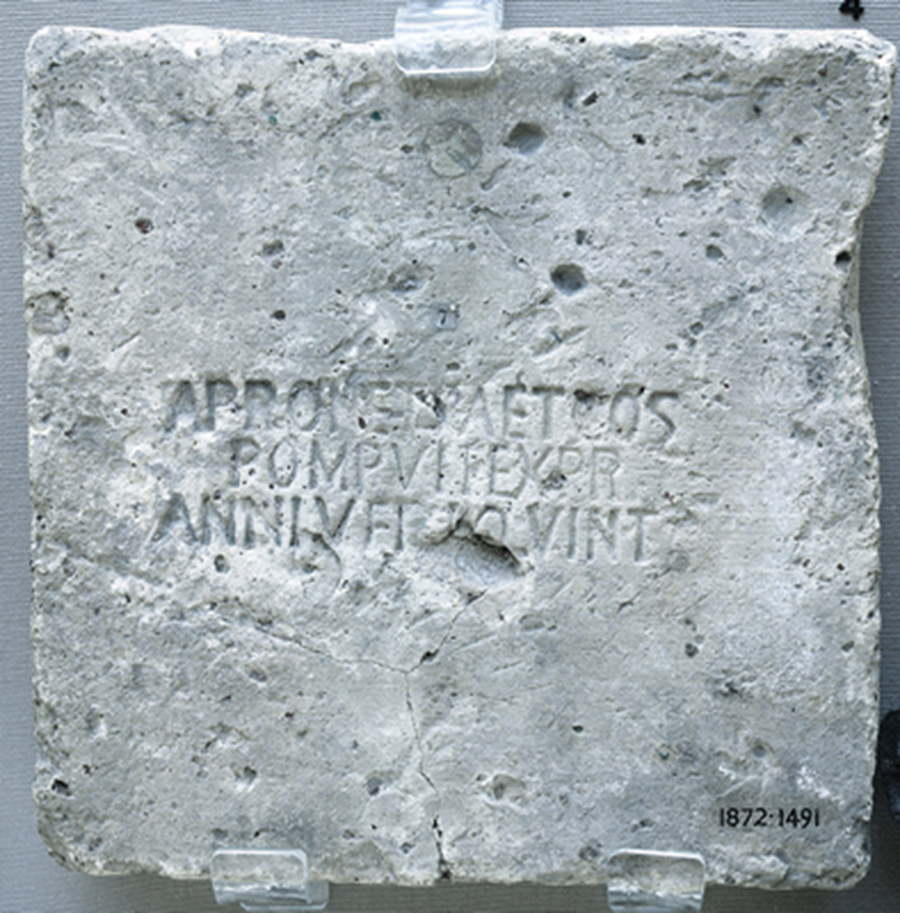
What is the inscription on this brick?
‘In the consulship of Apronianus and Paetinus. Of Pomponius Vitalis from the Quintanensian estate of Annius Verus’
Show an image of a red brickstamp:
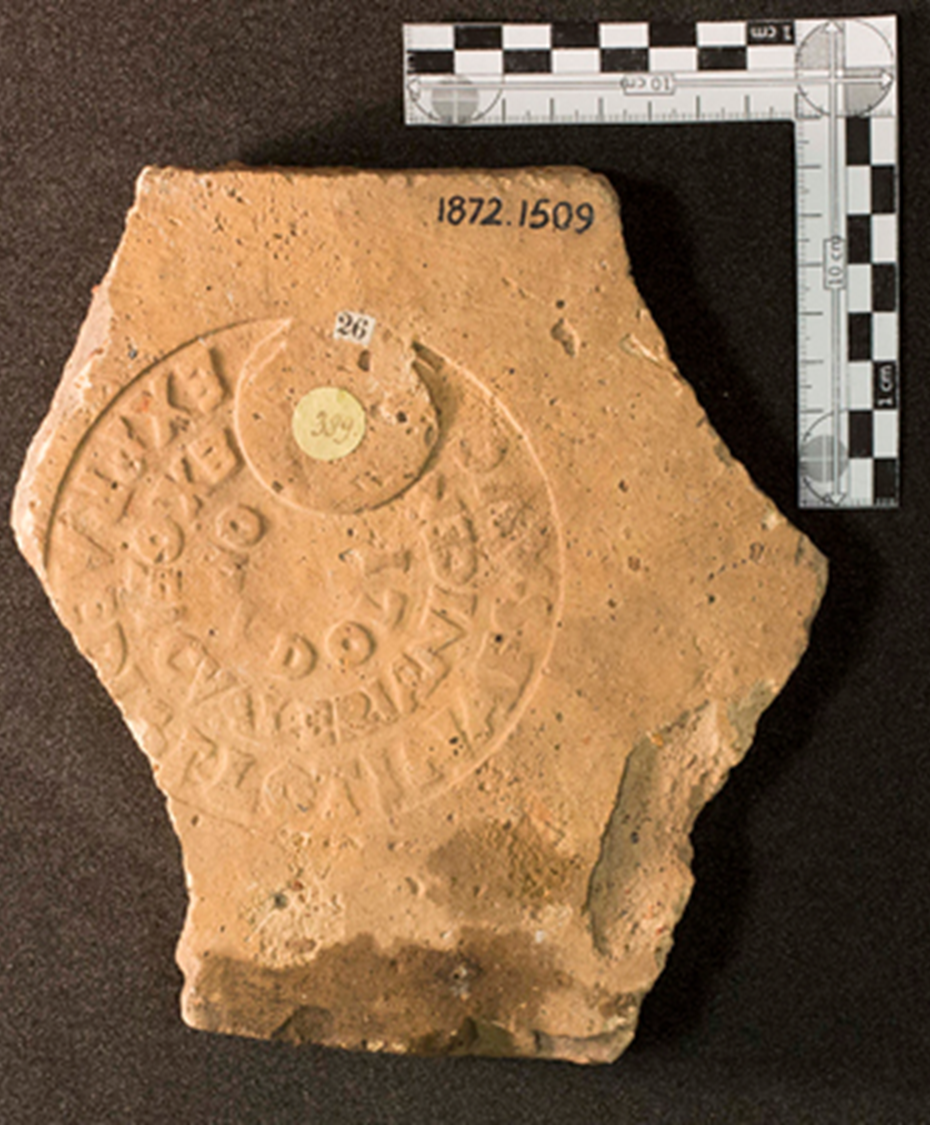
What does the inscription on this brick say?
‘Brick-product from the production unit of Valeria Nice from the estate of Plotina Augusta.’
Who are ancient texts often written by and what does this mean?
Tend to be written by the men of upper classes (texts), we learn little of other classes
What do inscriptions reveal?
Inscriptions reveal more about people who werent only from this class, such as slaves, women, immigrants (who arent mentioned in literary texts, and when they are it is often in satire and they are being mocked)
What is an example of an Inscriptions as ‘documents’ of social history?
The Gravestone of Myrrhine, first priestess of Athena Nike
What was the inscription on the gravestone?
The inscription: Far-shining memorial of Kallimachos’ daughter, who first tended the temple [5] of Nike. She had a name companion to her good repute, as by divine fortune Myrrhine she was called [10] in truth; she was first to tend the statue (?) of Athena Nike, (chosen) by lot from all, [15] Myrrhine by good fortune.
Why is there a focus on her name?
Focus on her name as it means myrtle, which the priestesses wore, so they’re essentially saying she was destined to have this role due to her name
When is this gravestone from?
410 BC
Show an image of this gravestone:
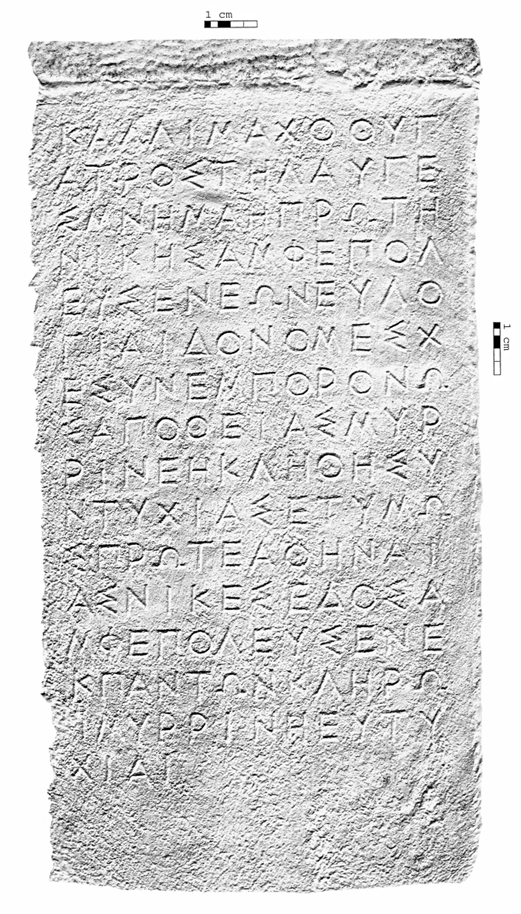
What is the ashwell hoard?
Golden dedications that have been found recently (2002), discovered by a metal detectorist in Hertfordshire
Who was this hoard burried by?
Clearly this was buried by someone who believed troubled times were coming and buried this with the aim to come back and retrieve all the gold but was never able to
What was in the hoard?
9 votive plaques set up by men and women, with texts that consist of punched dots (unsual way of producing lettering on mental)
What is the depiction on the votive plaque to Senuna?
The depiction looks very classical, a female goddess with a shield and spear
What do the inscriptions on this plaque tell us?
The isncrtiption tell the goddesses name is Senuna (possible a local deity connected to water), the name of the goddess combines Roman and Celtic elements. What looks roman about this: Latin inscription, the act of making a vow is a very roman way of communicating with the gods, the colums and pediment look very roman and and the depiction of the goddess is very roman. Celtic elements: her name, one of the dedicators has a celtic name
Show an image of the ashwell hoard:

Show an image of the votive plaque to Senuna:
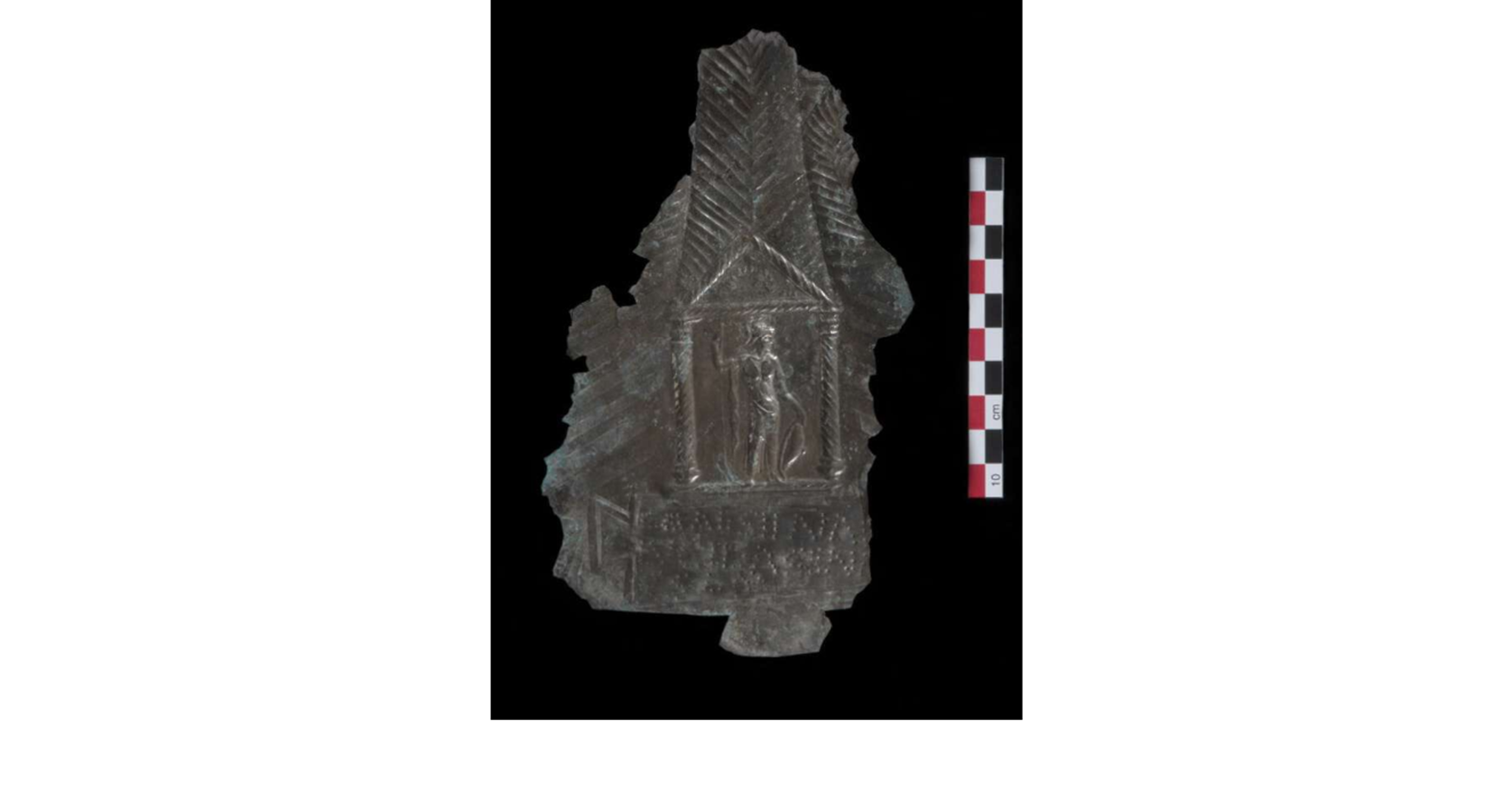
What does the Senuan plaque combine?
Roman and celtic elements
What Roman epitaph shows the emergence of christianity?
Epitaph of Licinia Amias, Rome
Display an image of this epitaph:
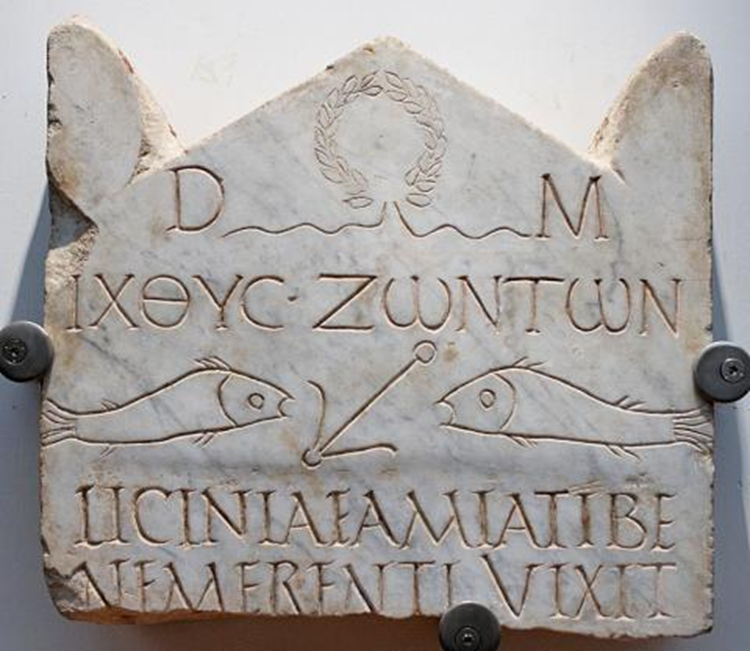
What does the inscription on the epitaph say?
Has a phrase in greek- ‘fish of the living’. Image of two fish beside an anchor
What did the word icthus mean?
The word Icthus, became a code connected to Jesus in early Christianity
What is the other interpretation of the fish on this tomb?
Annias the dedicator means tuna in greek so it could just be a depiction of fish because she is called tuna or it may be a code for praise of Jesus
What is the inscription inscribed over?
The inscription is inscribed over an old inscription (possibly from an early epitaph)
Give examples of Inscriptions of documents of political history:
Accounts of Pheidias' statue of Athena (final summary account)
Athenian Tribute List, 454/3 BC- tells a lot about who was revolting, its 3.8 metres high (powerful message of how athens allies were praising Athena, but also was a record of monetary stuff)
Decree about payment to priestess of Athena Nike
Show the pictures of those inscriptions:
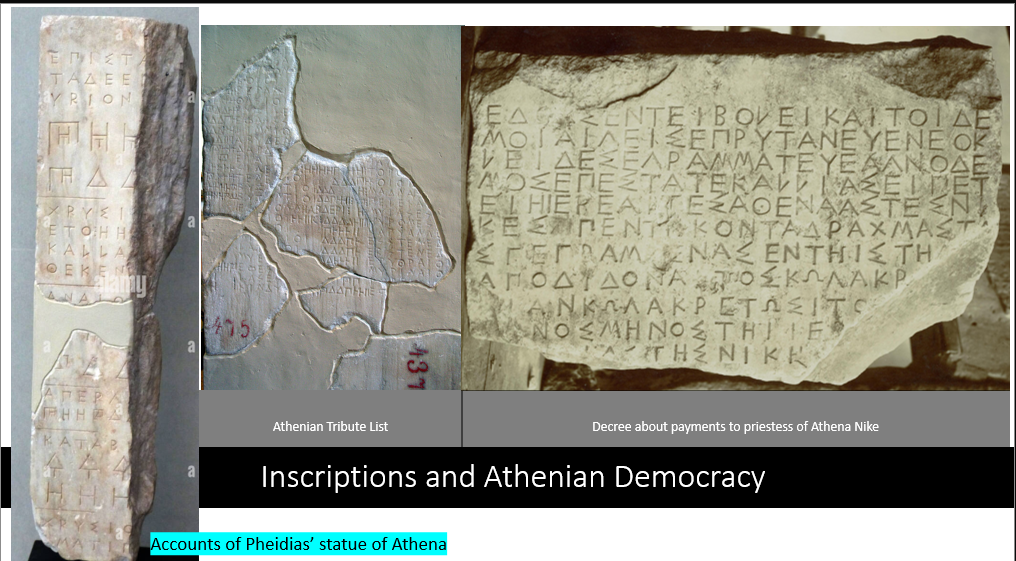
What are all those documents/inscriptions about?
All of these documents are about money, people are answerable for how they use public funds
When does the Accounts of Pheidias' statue of Athena (final summary account) date from?
460, 438/7 BC
What dies the inscription of the statue say?
The overseers . . . received these . . .silver money(≥) 700 tal. (≥) 520 dr. _____
Gold . . .. . . (≥) 200 dr.Kallaischros . . .dedicated . . . _____ Expenses: . . .(≥) 100 tal.(≥) 70 dr. _____ Finishing . . .(≥) 770 dr._____ Structure . . .(≥) 30 tal.(≥) 300 dr._____
Gold . . .for the statue . . .
When does the Athenian Tribute List date from?
IG I3 259, 454/3 BC
What does the inscription on the athenian tribute list say?
These first-fruits all separately, were the first to be declared to the Thirty by the hellenotamiai to whom - was secretary for the goddess from the allied tribute in the archonship of Ariston at Athens (454/3), one mina per talent.
col. 5 Abderites: 1285 dr. 2 ob. Olynthians,Skablaians,Asserites: 266 dr. 4 ob.Sermylians: 772 dr. Mekypernians Stolians, Polichnitans: 231 dr. 2 ob. Singians: (≥) 202 dr. 2 ob. Thasians: 300 dr. Mysians: 33 dr. 2 ob. Pikres of Syangelia: [50 dr.] Kedrietans: [50 dr.] Keramians: [150 dr.] Boutheians: . . . Kyllandians: [200 dr.] Chians, Karians: [33 dr. 2 ob.]. . .
col. 6 Narisbareans: [16 dr. 4 ob.] Mydones: [25 dr.] Kianians: 1[6 dr. 4 ob.] Artakenians: [33 dr. 2 ob.] Neapolis in Thrace: 1[6 dr. 4 ob.] Berysians under Ida: 16 dr. 4 ob. Karian Auliatans: 8 dr. [2 ob.] Iatans: 100 dr. Parianians: 100 dr. Daskyleionin Propontis: 8 dr. 2 ob. Aiginetans: 3000 dr. Milesians from Leros: 300 dr. Milesians from Teichioussa: . .
When does the 1. Decree about payment to priestess of Athena Nike date from?
IG I3 36, 424/3 BC?
What does the inscription say?
The Council and the People decided.AigeisII held the prytany. Neokleides was secretary (424/3?). Hagnodemos was chairman. Kallias proposed: for the priestess of Athena Nike the fifty drachmas written on the stele, the payment officers in office in the month Thargelion shall pay (them) to the priestess of Athena Nike . . .
Give an example of a reupdated treaty:
Reaffirmed alliance with Rhegion
When was this treaty updated?
433/2BC
Show an image of this treaty:
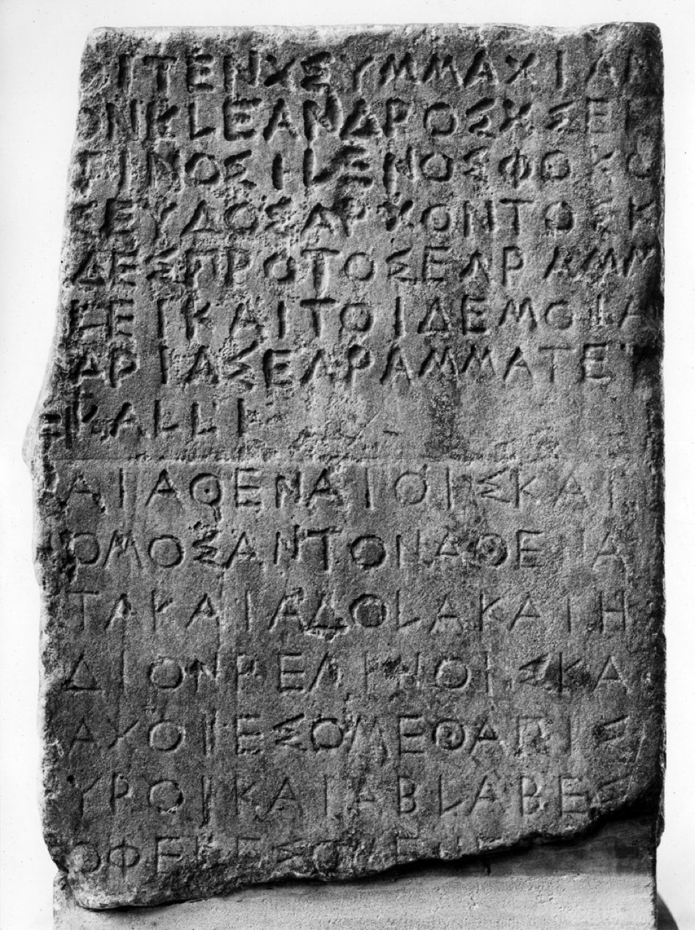
Who is the treaty dedicated to?
Dedicated to the gods (this is how a treaty is framed and guaranteed), notice to the envoys, it also states when it was who the secretary and chair was and who proposed the motion.
What are the signs that this treaty was updated/reinscribed?
Halfway down the stone there are signs of it being smoothed and recut, they shaved away the dates and updated it. The treaty is identical but has been updated to a new year with new people proposing and recording it
What does the inscription of the treaty say?
Gods. Envoys from Rhegion who made the alliance and the oath, Kleandros son of Xen–– son of –tinos, Silenos son of Phokos, [– son of –]. In the archonship of Apseudes (433/2) and under the Council for which Kritiades was first secretary. The Council and the People decided. Akamantis was the prytany. Charias was secretary. Timoxenos was chairman. Kallias proposed: there shall be an alliance between the Athenians and the Rhegians. The Athenians shall swear the oath [in order that everything may be] in good faith and without deceit and [straightforward on the part of the Athenians] for all time towards the Rhegians, [swearing as follows]: “we shall be faithful allies, [just] and strong and unharmful [for all time to the Rhegians, and] we shall oblige them if they[need anything]” . . .
Give an example of memory sanction in Britain:
In 2020 the statue of edward colston was thrown in a lake (slave trader), this idea of throwing away honourifc statues/inscriptions dates back to the Romans
The plinth (of the edward colston statue) has temporary inscriptions reinterpreting the meaning of the statue
Give an example of a Cancelleria Relief (vatican)
Emperor Domitian recut as Nerva (on a relief)
Show the relief that was changed:

Which of the men is the one that was changed?
what of domitians was changed?
Domitians name/statues werent always erased, only about 50% of them were erased
Domitian at Ostia, on the official calendar his name became Domitianus, the impertaor, caesar, vespasianus part has been removed
Why did the senate detsory domitians monuments?
For the senate, destroying Domitians monuments distanced themselves from a bad ruler and allowed them to have a fresh start